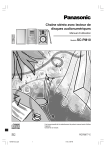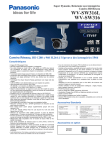Download TU-508 Manuel Instruction
Transcript
TU-508 Digital Stereo Tuner Syntoniseur numérique stéréophonique User Guide Guide d’utilisation TECHNI-CONTACT CANADA LTD./LTÉE Pointe-Claire, QC H9R 1A3 Calgary, AB T2C 4X7 TU-508 TU-508 Digital Stereo Tuner Important Safety Information WARNING: To reduce the risk of fire or electric shock, do not expose this apparatus to rain or moisture. 1. 2. 3. 4. 5. 6. 7. 8. 9. 10. 11. 12. 13. Read these instructions. Keep these instructions. Read all warnings. Follow all instructions. Do not use this apparatus near water. Clean only with dry cloth. DO NOT block any ventilation openings. Install in accordance with the manufacturer’s instructions. Do not install near any heat sources such as radiators, heat registers, stoves, or other apparatus (including amplifiers) that produce heat. Do not defeat the safety purpose of the polarized or grounding-type plug. A polarized plug has two blades with one wider than the other. A grounding-type plug has two blades and a third grounding prong. The wide blade, or the third prong, is provided for your safety. If the provided plug does not fit into your outlet, consult an electrician for replacement of the obsolete outlet. Protect the power cord from being walked on or pinched, particularly at plugs. Only use attachments/accessories specified by the manufacturer. Unplug this apparatus during lightning storms or when unused for long periods of the time. Refer all servicing to qualified service personnel. Servicing is required when the apparatus has been damaged or is not operating properly (damaged power-supply cord or plug, liquid spilled onto the unit or fallen objects into the apparatus, unit exposed to rain or dropped). CAUTION: TO PREVENT RISK OF ELECTRIC SHOCK, DO NOT REMOVE COVER (OR BACK). THERE ARE NO USER-SERVICESABLE PARTS INSIDE. REFER SERVICING TO QUALIFIED PERSONNEL. The lightning flash with arrowhead symbol, within an equilateral triangle, is intended to alert the user of a risk of the electric shock to persons. The exclamation point within an equilateral triangle is intended to alert the user to the presence of important operating and maintenance (servicing) instructions in the literature accompanying the appliance. FCC Statement (Part 15) – Radio Frequency Interference The TU-508 Digital Stereo Tuner generates and uses radio frequency energy and if not installed and used in strict accordance with the manufacturer’s instructions, may cause interference to radio and television reception. Testing is being conducted for compliance with the limits for a Class B device in accordance with the specifications in Part 15 of the FCC Rules and Canadian D.O.C regulations in order to provide reasonable protection against such interference. However, there is no guarantee that interference will not occur in a particular installation. If this equipment does cause interference to radio or television 2 TU-508 reception, which can be determined by turning the TU-508 unit off and on, the user is encouraged to try to correct the interference by one or more of the following measures: - Reorient the radio or TV receiving antenna. - Relocate the TU-508 unit with respect to the radio or TV receiver or vice-versa. - Plug the TU-508 unit into a different outlet (tuner and radio or TV receiver on different circuits) If necessary, the user should consult the dealer or an experienced radio/television technician for additional suggestions. The user may find the following flyer “Interference: Defining the Source,” helpful. This flyer was prepared by the Federal Communications Commissions (FCC) and is available on the website located at http://www.fcc.gov/cgb/consumerfacts/interference.html Before You Begin Your AMX TU-508 Digital Stereo Tuner incorporates the latest in PLL digital circuitry for reliable performance for years to come. To get the maximum benefit from your AMX product, please read all instructions provided with the unit. Package Contents (1) (1) (1) (1) (1) (1) (1) TU-508 Digital Stereo Tuner Remote Control Set of Rack Ears AM Radio Antenna (Loop) FM radio Antenna (Dipole) Stereo Patch Cable (RCA) User’s Manual 19” Rack Ears Installation A pair of rack ears are included to rack mount the TU-508 in a standard 19” audio/electronics rack. 1. Remove three screws from the side panel of the TU-508 toward the front. 2. Place rack ear in proper position, paying attention to correct alignment. 3. Reattach screws. 4. Repeat procedure for second rack ear, located on the other side of the unit. Important : Before installing the TU-508 in a rack, the four attached feet must be unscrewed and removed from the bottom of the unit. 3 TU-508 Front Panel Control 1. 2. 3. 4. 5. 6. 7. 8. POWER: Turns power to the unit ON or OFF POWER LED: Indicates that unit is powered ON INTRO: Scans preset stations MEMORY: Activates memory to save station preset CHANNEL+/-: Manually scrolls through programmed presets AM/FM: Switches between AM and FM TUNING: Tunes station frequency down (-) or up (+) STEREO/MONO: Selects STEREO or MONO operation for selected FM station Rear Panel Controls and Connectors 1. 2. 3. 4. 5. 6. 7. 75-Ohm: FM Antenna input 300-Ohm: FM Antenna input AM LOOP: AM Antenna input VOLUME: Attenuates output volume MONO: Audio connection for mono applications STEREO R/L: Audio connections for stereo applications AC Line: Connects to 120V, 60 Hz 4 TU-508 Remote Control All of the front panel control functions can also be adjusted by remote control 1. 2. 3. 4. 5. 6. 7. AM/FM: Switches between AM and FM operation MEM: Activates MEMORY to save station preset CH+/CH-: Manually scrolls through stations from available presets TU-/TU+: Tunes station frequency down (-) or up (+) MUTE: Mutes audio output (not available on front panel) INTRO: Scans preset stations ST/MO: Selects STEREO or MONO operation for selected FM station Additional functions: 1. 2. 3. 4. POWER: Turns power to the unit ON or OFF VFD: Selects different bar graph displays 0-9: Manually enter digits for desired preset 10+: Selects range in multiples of ten, for preset stations greater than “10” 5. P.CALL: Allows entry of actual station numbers. Select a band (either AM or FM), then press the P.CALL button. Next, enter the station number Antenna Connection FM Dipole Antenna The indoor dipole antenna provided should be adequate for normal FM reception. 1. Connect the antenna leads to the two terminals marked 300 Ohms (FM and GND). 2. Position the antenna for the best reception. Tack it to a wall or baseboard if possible. For reception when the TU-508 is installed in a rack, an external antenna installed in accordance with National Electric Codes may be required. FM Coaxial Cable Connector For applications using coaxial cable, an FM 75-Ohm coaxial cable connector is provided. AM Loop Antenna The TU-508 is provided with an external AM antenna for AM reception. 1. Carefully pull the antenna lead from the holding notch in the antenna and unwind the lead from the loop. 2. Connect the antenna leads to the terminals marked AM LOOP (AM and GND). 3. Snap the antenna into the base to form a free-standing unit. 5 TU-508 4. Position the antenna for best reception. If desired, the antenna may be permanently mounted using screws through the two holes in the base. Audio Connections An audio patch cable is provided. 1. Connect the two RCA plugs from one end of the cable to the R and L STEREO terminals on the TU508 (for mono applications, connect one end of cable to the MONO terminal.) 2. Connect the other end of the cable to an amplifier or mixer. OPERATION Note: These functions are the same whether accessed from the front panel of the TU-508 or from the Remote Control. Power Press the front panel POWER button to turn the TU-508. Turn the rear-mounted VOLUME control counterclockwise to attenuate audio output and clockwise for full output. To Select a Band Press the button marked AM/FM. The current band selected (AM or FM) appears on the display. You can preset up to a total of 60 stations for both AM and FM bands combined. FM stations may be played in either stereo or mono; press the STEREO/MONO button to change mode. To Tune a Station Pressing the TUNING + or TUNING- button advances to the next frequency. Pressing and holding the TUNING+ or TUNING- button will activate the auto search feature. The word AUTO appears on the display, and the search will continue to the next clear station signal. To stop the auto search at any frequency, press either the TUNING+ or TUNING- button again. To Preset Stations 1. Select a band and tune the first desired station. 2. Press the MEMORY button and then one of the CHANNEL+/-buttons to select the preset number. The two-digit preset number appears on the display. The display flashes twice and then the preset is stored. 3. Repeat the procedure for each desired preset. To Scan Preset Stations 1. Press the INTRO button. Each preset station will play for a few seconds in turn while scanning. 2. To select a station during scanning, press the INTRO button again. 6 TU-508 To Select Preset stations Using Remote Control The number buttons can be used to select a specific preset station. For presets greater than 10, press 10+ for each multiple of 10 (for example, 10, 20, 30, etc.), then select the preset in that multiple. Example: To select preset 52, press 10+ five times, then press 2. Pressing P.CALL allows actual station numbers to be entered. 1. Select a band. 2. Press the P.CALL button. 3. Enter the station numbers. SPECIFICATIONS Band coverage : FM : 87.00 to 108.5MHz AM : 530 to 1710KHz Tuning : PLL Synthesizer Channel Indicator : LCD Panel Station Tuning : Push-button Preset Memory : 60 Total stations (AM and FM) Antenna Connectors : FM : 75 Ohms, coax: 300 Ohms, push-release. AM : Push-release Output : Stereo/Mono via RCA jacks, AUX Program Selection : Push-button via front panel or remote control Output Terminals : RCA Accessories Included : AM Loop and FM Dipole antennas Remote Control (uses two AA batteries) RCA Stereo Cable Operating Voltage : 120v. AC, 60Hz, 0.15A max Dimensions : 16 7/8’’ L x 1 ¾’’ H x 10’’ P (without feet) 16 7/8’’ L x 2’’ H x 10’’ P (with feet) Weight : 4.75 lb 7 TU-508 TU-508 Syntoniseur numérique stéréophonique Information sur les précautions à suivre AVERTISSEMENT : Afin de réduire le risque de feu ou de chocs électriques, ne jamais exposer cet appareil à l’eau ou l’humidité. 1. 2. 3. 4. 5. 6. 7. 8. 9. 10. 11. 12. 13. Lire les instructions attentivement. Conserver ces instructions. Prendre note des avertissements. Suivre les instructions. Ne pas utiliser cet appareil près de l’eau. Nettoyer seulement avec un linge sec. NE PAS bloquer les ouvertures de ventilation. Installer selon les recommandations du fabricant. Ne pas installer l’appareil près d’un radiateur, d’une sortie d’air chaud, d’un poêle ou toute autre source de chaleur. Ne pas éliminer la polarisation de la fiche du secteur 117V. Ce type de fiche avec mise à la terre est conçu pour ajouter une meilleure protection à votre appareil. Dans l’impossibilité de brancher ce type de fiche, consulter un électricien afin qu’il puisse remplacer la prise murale. Protéger la corde d’alimentation contre les écrasements et les pincements particulièrement autour de la fiche ou de l’appareil. Utiliser seulement des périphériques recommandés par le manufacturier. Débrancher cet appareil durant les orages électriques ou si l’appareil n’a pas à être utilisé durant de longues périodes. Confier la réparation à un technicien qualifié en cas de défaut ou de dommage (si l’appareil entre en contact avec un liquide, s’il subit un choc, s’il ne fonctionne pas adéquatement, etc.). PRÉCAUTIONS : AFIN DE PRÉVENIR LES RISQUES DE CHOCS ÉLECTRIQUES, NE PAS ENLEVER LE COUVERCLE OU L’ARRIÈRE. AUCUNE PIÈCE NE PEUT ÊTRE REMPLACÉE À L’INTÉRIEUR. CONFIER L’APPAREIL À UN TECHNICIEN QUALIFIÉ. Le symbole de l’éclair dans un triangle indique à l’utilisateur la présence de voltage dangereux à l’intérieur qui constitue une menace évidente pour toute personne. Le symbole de point d’exclamation dans un triangle indique au consommateur que des informations sur l’entretien et l’opération de l’appareil sont incluses avec l’appareil. Déclaration de la FCC (partie 15)- Interférence de radiofréquences Le syntoniseur stéréophonique TU-508 génère et utilise de l’énergie générée par des radiofréquences qui peuvent causer de l’interférence aux appareils de radio et de télévision s’il n’est pas installé correctement. Des tests sont effectués pour assurer la conformité des normes et spécifications de la Classe B (FCC Partie 15) et du code canadien D.O.C. afin d’assurer une efficacité raisonnable contre les interférences. Néanmoins, il n’existe pas de garantie que ce type d’interférence ne sera pas présent 8 TU-508 dans certaines installations spécifiques. Si cet équipement cause de l’interférence à des radios ou téléviseurs en allumant ou éteignant le TU-508, l’utilisateur est encouragé à corriger l’interférence en suivant les recommandations suivantes : - Rediriger l’antenne de l’appareil radio ou du téléviseur. - Relocaliser le TU-508 par rapport aux appareils affectés. - Brancher le TU-508 dans une prise différente de façon à ce que la radio ou le téléviseur ne soit pas sur le même circuit. Si nécessaire, l’utilisateur devrait consulter le revendeur ou un technicien expérimenté en radio/télévision pour des suggestions supplémentaires. L’utilisateur peut consulter la brochure suivante, ‘’Interférence : Définir la source’’ (en anglais seulement) disponible sur le site de la Commission Fédérale des Communications (FCC) au www.fcc.gov/cgb/consumerfacts/interference.html Avant de débuter l’installation Votre syntoniseur numérique stéréophonique TU-508 incorpore les technologies PLL numériques les plus récentes de façon à fournir un rendement maximal pour plusieurs années à venir. Afin de profiter des nombreuses caractéristiques de votre appareil AMX, assurez-vous de lire toutes les instructions incluses avec l’unité. Contenu de l’emballage (1) (1) (1) (1) (1) (1) (1) Syntoniseur digital TU-508 stéréophonique Une télécommande Ensemble de fixation pour montage sur bâti Antenne cadre AM Antenne dipôle FM Câble de raccordement fiches RCA Manuel d’instructions Installation des supports pour montage sur bâti 19’’ Une paire d’adaptateurs pour montage sur bâti 19’’ est incluse avec l’appareil. 1. Retirer trois vis du côté de l’appareil (vers l’avant) 2. Installer un des supports dans la position recommandée en s’assurant d’avoir la bonne position 3. Réinstaller les trois vis originales 4. Répéter la même procédure pour le côté opposé de l’appareil IMPORTANT : Les pieds de caoutchouc doivent être retirés du dessous de l’appareil avant une installation de ce type. 9 TU-508 Panneau avant de l’appareil 1. 2. 3. 4. 5. 6. 7. 8. POWER : Active l’appareil en position On/Off VOYANT DEL : Indique que l’appareil est en fonction INTRO : Balayage des stations préréglées MEMORY : Enclenche la mémoire pour la sauvegarde des stations préréglées CHANNEL +/- : Permet le balayage des stations préréglées AM/FM : Permet la commutation entre les bandes AM et FM TUNING : Bouton pour sélectionner les stations par fréquences vers le bas ou le haut. STEREO/MONO : Choisit l’opération en stéréo ou mono pour les stations de la bande FM Panneau arrière de l’appareil 1. 2. 3. 4. 5. 6. 7. 75-Ohm : Entrée antenne FM 300-Ohm : Entrée antenne FM AM LOOP : Entrée antenne AM VOLUME : Contrôle d’atténuation du volume de sortie MONO : Sortie audio pour une application monophonique STEREO R/L : Sortie audio pour une application stéréophonique AC Line : Branchement de l’alimentation 120V, 60Hz 10 TU-508 Télécommande Toutes les fonctions situées sur le panneau frontal de l’appareil sont aussi disponibles sur la télécommande. 1. AM/FM : Pour passer de la bande AM à la bande FM 2. MEM : Activer la fonction MEMORY afin de sauvegarder les stations préréglées 3. CH +/CH- : Permet le balayage manuel des stations préréglées 4. TU-/TU+ : Permet la sélection des fréquences de haut en bas ou l’inverse 5. MUTE : Permet la sourdine sur la sortie de l’appareil (non disponible sur l’appareil) 6. INTRO : Balayage des stations préréglées 7. ST/MO : Choisit l’opération en stéréophonie ou monophonie pour les stations FM Autres fonctions: 1. POWER : Active ou désactive l’appareil 2. VFD : Permet d’afficher différentes barres graphiques 3. 0 à 9 : Pour entrer les choix des différentes mémoires 4. 10+ : Permet de choisir les stations par multiples de 10 sur la bande lorsque le chiffre requis est supérieur à 10 5. P. CALL : Permet d’entrer la fréquence exacte des stations de radio : sélectionner une bande (AM ou FM), appuyer sur le bouton P. CALL puis entrer la fréquence de la station Branchement de l’antenne Antenne FM Dipôle L’antenne intérieure dipôle fournie avec l’appareil devrait être adéquate pour une réception FM conventionnelle. 1. Brancher les extrémités de l’antenne aux deux terminaux indiqués 300 Ohms (FM et GND). 2. Positionner l’antenne pour une réception maximale. Il est préférable de la fixer à un mur ou une plainte murale. Pour le montage sur bâti 19’’, un raccordement à une antenne extérieure est recommandé et doit être conforme aux normes du National Electric Codes. Branchement sur câble coaxial FM Une prise pour le branchement d’une fiche de type coaxiale 75 ohms est prévue sur l’appareil. Antenne cadre AM Le TU-508 est fourni avec une antenne AM afin de maximiser la réception. 1. Dérouler le câble de branchement de l’antenne. 11 TU-508 2. Brancher l’antenne aux terminaux indiqués AM LOOP (AM et GND). 3. Enclencher l’antenne dans sa base pour l’attacher au socle. 4. Diriger l’antenne pour une réception maximale. Vous pouvez aussi choisir de fixer l’antenne d’une façon permanente en utilisant les deux trous situés à la base. Branchements Audio Un câble audio est fourni à cet effet. 1. Relier les fiches de type RCA aux prises R et L STEREO sur le TU-508 (pour une installation monophonique, brancher seulement un câble à la prise MONO). 2. Brancher l’autre extrémité à l’entrée AUX d’un amplificateur ou d’un mélangeur. UTILISATION Note : Les fonctions décrites ci-dessous sont les mêmes peu importe si elles sont sélectionnées sur le panneau avant de l’appareil ou avec la télécommande. Alimentation Pousser le bouton POWER sur l’appareil afin de placer l’appareil en fonction. Tourner le bouton du volume de sortie situé à l’arrière dans le sens opposé des aiguilles d’un montre afin d’atténuer la sortie et dans le sens opposé pour obtenir le niveau de sortie maximal de l’appareil. Sélection des bandes Appuyer sur le bouton indiqué AM/FM. La bande choisie apparaît sur l’afficheur. 60 Stations préréglées sur les bandes AM et FM combinées peuvent être enregistrées au total. Les stations FM peuvent être jouées en stéréophonie ou monophonie; appuyez sur le bouton STEREO/MONO afin de changer d’option. Pour syntoniser une station Appuyer sur le bouton TUNING+ ou TUNING- pour atteindre la station suivante ou précédente. Appuyer et maintenir enfoncé TUNING+ ou TUNING- pour activer la fonction auto-recherche. A ce moment, l’indicateur AUTO recherche apparaîtra sur l’afficheur et l’appareil continuera à rechercher une station émettrice. Pour mettre fin à la recherche AUTO, appuyer de nouveau sur un des deux boutons TUNING+ et TUNING-. Mettre en mémoire des stations préréglées 1. Choisissez la bande et la station à prérégler en mémoire. 2. Appuyer sur le bouton MEMORY et en même temps le bouton CHANNEL+/- afin de choisir le numéro de position. Le numéro de préréglage à deux chiffres apparaîtra à l’afficheur puis clignotera deux fois indiquant ainsi que le la station est gardée en mémoire. 3. Répéter la même procédure pour chacune des stations à sauvegarder en mémoire. 12 TU-508 Balayage des stations sauvegardées en mémoire 1. Appuyer sur le bouton indiqué INTRO. Chacune des stations préréglées joueront, tour à tour, pendant un court moment durant le balayage de toutes les stations. 2. Pour arrêter sur une station, appuyer de nouveau sur le bouton INTRO. Choisir les stations préréglées en utilisant la télécommande Les boutons chiffrés peuvent être utilisés pour faire le choix de la station préréglée. Pour les sélections supérieures au chiffre 10, appuyer sur 10+ pour chaque multiple de 10 (par exemple, 10, 20, 30 etc.) puis le chiffre unitaire. Exemple : Pour choisir 52, appuyer sur 10+ cinq fois et puis sur le chiffre 2. Appuyer sur le bouton P. CALL pour obtenir la station préréglée directement en entrant son numéro. 1. Choisir une bande (AM ou FM) 2. Appuyer sur le bouton P. CALL 3. Entrer le numéro de préréglage assigné à la station SPÉCIFICATIONS Bande de réception : FM : 87.00 à 108.5MHz AM : 530 à 1710KHz Syntonisation : PLL Synthétiseur Indicateur de canaux : Panneau ACL Choix des stations : Bouton-poussoir Mémoires préréglées : 60 stations au total (AM et FM) Fiches de branchement de l’antenne : FM : 75 Ohms, coaxiale : 300 Ohms, à pression. AM : à pression Sorties : Stéréo/Mono via fiche RCA, niveau AUX Sélection des programmes : Bouton-poussoir par le panneau frontal ou la télécommande Bornes de sortie : Prises RCA Accessoires inclus : Antenne AM de type cadre et FM de type dipôle Télécommande (utilise deux piles AA) Cordon audio avec fiches RCA Voltage de l’appareil : 120v. AC, 60Hz, 0.15A max Dimensions : 16 7/8’’ L x 1 ¾’’ H x 10’’ P (sans les pieds) 16 7/8’’ L x 2’’ H x 10’’ P (avec les pieds) Poids : 4.75 lb 13













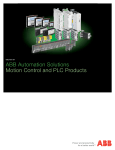
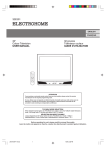
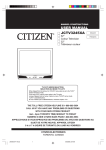

![3T11131A [COVER]](http://vs1.manualzilla.com/store/data/006164578_1-b091c799fbe2f54ad080b700a0e61ea1-150x150.png)
![3T30631A [COVER]](http://vs1.manualzilla.com/store/data/006334567_1-569f92049c2ac3665fee2b2debb524ca-150x150.png)
